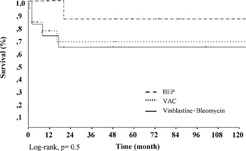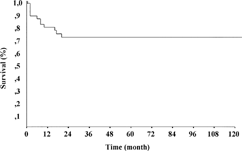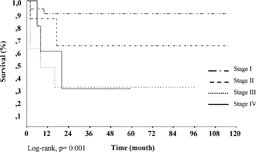Abstract
We analysed the treatment results of 52 children with testicular germ cell tumors. Histopathological diagnoses were endodermal sinus tumor (63.4%), embryonal carcinoma (28.8%), teratocarcinoma (5.7%), and mixed tumors (2.1%). Radical inguinal orchiectomy was performed in 42 patients and retroperitoneal lymph node dissection in 10 (3/10 positive). Overall survival rates were: whole group: 71.2%; stage I: 89.7%; II: 68.5%; III: 31.2%; IV: 30% (p =. 001). Five-year overall survival rates were 85.8% and 100% for stage I patients who received chemotherapy or not (p =. 27); BEP regimen: 85.7%; classical VAC: 67.9%; vinblastine + bleomycin: 63.6%. Chemotherapy is not required in stage I. BEP regimen is effective in testicular germ cell tumors.
Keywords:
Testicular tumors in children are uncommon, comprising about 2–5% of malignancies in boys Citation[1]. Germ cell tumors consitute about 75% of testicular tumors in childhood Citation[2]. There are little reliable data on the management of testicular germ cell tumors (TGCT) in children, because most series are too small. The treatment of pediatric patients with TGCT has been historically based on adult experience. Survival rate has been improved to 90% in 1990s by using tumor markers, developed diagnostic approaches, and platinum-based combination chemotherapy in adults Citation[3]. However, clinical behavior and histological types of TGCT in children are different from those in adults Citation[4]. The aim of this study was to evaluate the clinical characteristics and treatment results of children with TGCT treated at our center since 1972.
METHODS AND PATIENTS
Fifty-two children with newly diagnosed TGCT were treated in our hospital between January 1972 and December 1998. Clinical and laboratory features have been recorded from the patient files. Their diseases were staged according to “POG/CCG germ cell testes tumor staging system” Citation[5]. Retroperitoneal lymph node dissection (RLND) was performed in 10 patients who were admitted before 1989. Patients with stage I disease diagnosed before 1991 and all patients with stage II, III, IV disease received chemotherapy. After 1991, 9 patients who had stage I disease were just followed-up by tumor markers and radiological imaging. Different chemotherapy regimens were used between 1972 and 1998 (). Response to three different chemotherapy protocols including vinblastine plus bleomycin (vinblastine 0.2 mg/kg/day, weekly; bleomycin 0.5 mg/kg/day, every 4 weeks); classical VAC (V: vincristine, 2 mg/m2/week, IV, X12; A: actinomycin, 15 μ g/kg/day, IVX5, every 6 weeks; C: cyclophosphamide, 2.5 mg/kg/day, P.O.) and BEP (B: bleomycin 15 mg/m2, day 2; E: etoposide, 120 mg/m2/day, X3, IV infusion; P: cis-platinum, 100 mg/m2, day 1, IV infusion; every three weeks) were evaluated since one or two patients were treated with the other regimens.
The Characteristics of Patients with Testicular Germ Cell Tumors
Survival rates were calculated by using the Kaplan-Meier method, compared with log-rank test Citation[6].
RESULTS
The ages of the patients ranged from 2 months to 16 years (median 2, mean 2.9 ± 0.5 years). While 43 patient (82.7%) were younger than 3.5 years, only four patients' ages were between 13 and 16 years. The clinical and laboratory characteristics of the patients are shown in . The complaints at admission were scrotal swelling in 49 patients, abdominal swelling in 2 patients, and one had both of them. All patients had testicular masses, although several had abdominal mass and supraclavicular lymphadenopathy. Median duration of symptoms was 60 days (4–720 days).
Serum alpha-fetoprotein (AFP) levels were measured in 33 patients and β -human chorionic gonadotropin (β -hCG) levels were measured in 25 patients. Alpha-fetoprotein was elevated in 87.8%, while β -hCG was elevated in 48% of the patients.
Radical inguinal orchiectomy was the initial surgical procedure in 46 patients. Scrotal orchiectomy had been performed in six patients at another center, all of them had second operations for high ligation. Retroperitoneal lymph node dissection was performed in 10 patients and pathologic examination was positive in only three of them. The histopathological subgroups and stage distribution are given in . Twenty-five percent of patients had advanced disease (stages III and IV), although the remaining had early disease (stages I and II). Endodermal sinus tumor (EST) was the major group. Twenty-five of 33 patients with EST had early disease, 8 patients had advanced disease. Four of 15 patients with embryonal carcinoma presented with advanced disease. There was no significant difference between EST and embryonal carcinoma regarding the distribution of early and advanced disease (p = 0.56). Sites of metastases at diagnosis were abdomen (12 patients), lung (3 patients), liver (2 patients), and supraclavicular lymph node (1 patient).
Nine patients with stage I disease were treated with orchiectomy alone, seven of them had EST, one of them had embryonal carcinoma, the other one had teratocarcinoma and all of them survived without relapse. Forty-three patients received different chemotherapy regimens (). Five-year overall survival rate was 71.2% for the whole group (). Five-year overall survival rates were 85.7%, 67.9% and 63.6% for patients treated with BEP, classical VAC, and vinblastine plus bleomycin, respectively (p = 0.5) (). Five-year overall survival rates were 74.1% and 64.0% in patients with EST and embryonal carcinoma, respectively (p =. 57). Five-year overall survival rates were not different for stage I patients receiving chemotherapy and those not receiving chemotherapy (85.8% versus 100%, p =. 27). Long-term survival rates were 89.7%, 68.5%, 31.2%, and 30% for stage I, II, III, and IV disease, respectively (p =. 001) ().
2 Survival of 37 patients treated with different chemotherapy regimens. (VAC: vincristine + actinomycin D + cyclophosphamide; BEP: bleomycin + etoposide + cis-platinum).

Radiotherapy was given in only six patients because of the metastases at the time of diagnosis, four of them died of progressive disease and the others have no evidence of disease.
Two patients developed metastases (one with lung metastases, the other with abdominal metastases) at 10 months, one had embryonal carcinoma and the other EST. They died of disease after 1 and 7 months from the time of metastases.
One patient with mixed germ cell tumor in stage IV was treated with BEP regimen and survived disease free. One of the two patients with stage I teratocarcinoma was treated with orchiectomy alone and survived without relapse. The other one received VAC regimen and was lost to follow-up with disease at third month. Three patients with teratocarcinoma had stage II disease received BEP regimen and survived disease free.
DISCUSSION
Testicular germ cell tumors have two peak incidence, before 3 years of age and adolescence, but most of the patients are younger than 3 years. The median age at diagnosis varied between 12 and 42 months in the reported series Citation[7–9]. The age distribution in our series is similar to that reported in the literature and 82.7% of patients were younger than 3.5 years. Painless scrotal swelling is the most common presenting sign in children Citation[1, 7–9] and according to Prepubertal Testicular Tumor Registry Citation[10], 87% of 327 patients had presented with scrotal swelling. In our cases, the most common complaint was scrotal swelling similar to the other series.
Serum AFP and β -hCG levels were high in 87.8% and 48.0% of the patients, respectively. They are useful markers for diagnosis, staging, response to treatment, and for the follow-up. However, metastases can develop in patients with normal tumor markers, but rarely Citation[1]. Tumor markers in our patients diagnosed before 1982 were not available.
Endodermal sinus tumor is the most common TGCT in children and occurs in 54–93% of these patients Citation[1, 10, 11]. Embryonal carcinoma is seen rarely in children. According to Pediatric Oncology Group (POG) registry, embryonal carcinoma makes 7% of patients with TGCT Citation[12]. On the other hand, Wolner et al. Citation[8] reported that 41% of patients had pure embryonal carcinoma. In another series, 16.6% of patients had embryonal carcinoma Citation[1]. Most of patients with embryonal carcinoma were adolescents Citation[1, 13]. In our series 63.5% of patients had EST, 28.8% embryonal carcinoma and only 4 out of 15 patients with embriyonal carcinoma were adolescents.
Approximately, 80–85% of testicular ESTs were stage I Citation[1, 10, 14]. Children with EST present with lower stages than patients with embryonal carcinoma Citation[1]. However, there was no relation between stage and histologic type in our series. Our patients had longer duration of symptoms than those from the literature. This could explain why there is no difference in the stage distribution of children with EST or embryonal carcinoma in our study.
Radical inguinal orchiectomy followed by RLND had been accepted as a standard approach in the management of TGCT in 1970's Citation[15]. Brosman Citation[2] reported of 98 children with yolk sac tumors who underwent systematic lymphadenectomy, only 4 were found to have lymph node involvement. In children who were without clinical or radiological evidence of metastases, only 4.6% of bilateral and 13.7% of unilateral lymph node dissections yielded tumor. There were no differences regarding the relapse-free survival rates of patients with or without RLND Citation[9]. Retroperitoneal lymph node involvement is less frequent in children than in adults Citation[4] and there is a significant risk of postoperative ejaculatory dysfunction Citation[16]. Therefore, routine RLND in stage I patients has been questioned in 1980's Citation[5, 7, 9]. In our series, RLND was performed in 10 patients and found positive pathologically in only 3 patients. After 1989, this approach was stopped and all patients were staged using tumor markers and radiological imaging.
The use of chemotherapy for stage I patients has been suggested in some studies even in patients with negative retroperitoneal lymph node examination Citation[15]. Griffin et al. Citation[7] and Green Citation[9] showed that chemotherapy did not affect survival rates in patients with localized disease and suggested that orchiectomy alone is effective for stage I disease.
Eighty percent of patients with clinical stage I EST were cured by orchiectomy alone Citation[14]. Mann et al. Citation[11] reported that 67.2% of 61 patients with TGCT were cured by only orchiectomy and it increased up to 96% by chemotherapy. According to the UKCCSG second GCT Study, 51 of 63 testicular malignant germ cell tumors were stage I and were treated by radical inguinal orchiectomy alone. Eleven of these 51 patients developed recurrence, but all were salvaged by JEP regimens. The overall survival of all testicular tumors was 100% Citation[17]. In German Cooperative Studies (MAHO), 140 patients with stage I EST were treated according to “watch and wait” strategy, 13% of patients needed chemotherapy after 6–60 weeks from orchiectomy and all were salvaged Citation[18]. Liu et al. Citation[19] compared the treatment results of patients receiving chemotherapy and not receiving chemotherapy after orchiectomy in stage I patients with EST younger than 2 years. Two relapses developed in patients who were not given chemotherapy, while no relapse was detected in patients receiving chemotherapy. Nine of our patients with stage I were not given chemotherapy and all had survived disease free. The patients with stage I disease diagnosed before 1991 received chemotherapy and one died after lung metastases. Our study confirmed that chemotherapy is unnecessary in patients with stage I testicular germ cell tumors and radical inguinal orchiectomy alone is adequate for patients with stage I disease. 13–20% of patients treated according to ‘watch and wait’ approach suffer relapse and they also could be salvaged by chemotherapy Citation[14, 17, 18]
Scrotal orchiectomy is not suggested since it facilitates contamination of surgical fields, alter lymphatic drainage and promote metastases Citation[1]. Relapse develops in 20.8% of patients treated by scrotal orchiectomy while 7.7% of patients treated by inguinal orchiectomy Citation[20]. In our study, six patients had scrotal orchiectomy as initial surgical procedure in other centers before they were referred to us. These patients were reoperated at our center.
We recommend that chemotherapy be given to stage II to IV patients and relapsed stage I patients as suggested by Mann Citation[11, 17], Flamant Citation[14] and Schmidt Citation[18] and their colleagues. Although the survival rates were not statistically significant, BEP regimen seems superior to others. The small number of patients might have a role for the significance of statistical test. In conclusion, TGCT in children have a favorable prognosis. No treatment is necessary for patients with stage I disease after orchiectomy. Prospective randomized studies would be helpful to determine the risk factors for advanced disease and more intensive regimens for children with advanced disease should be investigated by randomized studies.
REFERENCES
- Fernandes E T, Etcubanas E, Roo B N, et al, Two decades of experience with testicular tumors in children at St. Jude Children's Research Hospital. J Ped Surg.. 1989; 24: 677–682
- Brosman S A. Testicular tumors in prepubertal children. Urology. 1979; 13: 581–588. [CROSSREF], [PUBMED], [INFOTRIEVE]
- Sogani P C, Perrotti M, Herr H W, et al, Clinical stage I testis cancer: long-term outcome of patients on surveillance. J Urol.. 1998; 159: 855–858. [PUBMED], [INFOTRIEVE]
- Young P G, Mount M B, Foote F W, et al, Embryonal adenocarcinoma in the prepubertal testis. Cancer. 1970; 26: 1065–1075. [PUBMED], [INFOTRIEVE]
- Castleberry R P, Cushing B, Perlman E, et al, Germ cell tumor. Pizzo P A, Poplack D G. Principles and Practice of Pediatric Oncology, 3rd ed., Philadelphia, Lippincott Raven Publishers. 1997; 921–945
- Peto M, Pike R C, Armitage P, et al, Design and analyses of randomised clinical trials requring prolonged observation of each patients. Br J Cancer. 1977; 35: 1–39. [PUBMED], [INFOTRIEVE]
- Griffin G C, Raney R B, Synder H M, et al, Yolk sac carcinoma of the testis in children. J Urol.. 1987; 137: 954–957. [PUBMED], [INFOTRIEVE]
- Wolner N, Ghavimi F, Wachtel A, et al, Germ cell tumors in children: gonadal and extragonadal. Med Pediatr Oncol.. 1991; 19: 228–239
- Green D M. Testicular tumors in infants and children. Semin Surg Oncol.. 1986; 2: 156–162. [PUBMED], [INFOTRIEVE]
- Kay R. Prepubertal Testicular Tumor Registry. Urol Clin North Am.. 1993; 20: 1–5. [PUBMED], [INFOTRIEVE]
- Mann J R, Pearson D, Barrett A. Results of the United Kingdom Children's Cancer Study Group's malignant germ cell tumor studies. Cancer. 1989; 63: 1657–1667. [PUBMED], [INFOTRIEVE]
- Hawkins E P, Finegold M J, Hawkins H K, et al, Non-germinomatous malignant germ cell tumors in children: a review of 89 cases from the Pediatric Oncology Group, 1971–1984. Cancer. 1986; 58: 2579–2584. [PUBMED], [INFOTRIEVE]
- Terenziani M, Piva L, Spreafico F, et al, Clinical stage I nonseminomatous germ cell tumors of the testis in childhood and adolescence: an analysis of 31 cases. J Ped Hematol Oncol.. 2002; 24: 454–458
- Flamant F, Nihaul-Fekete C, Patte C, et al, Optimal treatment of stage I yolk sac tumor of the testis in children. J Pedatri Surg.. 1986; 21: 108–111
- Hopkins T B, Jaffe N, Colondy A, et al, Management of testicular tumors in children. J Urol.. 1978; 120: 96–102. [PUBMED], [INFOTRIEVE]
- Kedia K R, Markland C, Fraley E E. Sexual function following high retroperitoneal lymphadenectomy. J Urol.. 1975; 114: 237–239. [PUBMED], [INFOTRIEVE]
- Mann J R, Raafat F, Robinson K, et al, The United Kingdom Children's Cancer Study Group's second germ cell tumor study: carboplatin, etoposide, and bleomycin are effective treatment for children with malignat extracranial germ cell tumors, with acceptable toxicity. J Clin Oncol.. 2000; 18: 809–818
- Schmidt P, Haas R J, Gobel U, et al, Results of the German studies (MAHO) for treatment of testicular germ cell tumors in children—an update. Klin Padiatr. 2002; 214: 167–172. [CROSSREF], [PUBMED], [INFOTRIEVE]
- Liu H C, Liang D C, Chen S H, et al, The stage I yolk sac tumor of the testis in children younger than 2 years, chemotherapy or not?. Pediatr Hematol Oncol.. 1998; 15: 223–228. [PUBMED], [INFOTRIEVE]
- Pizzocaro G, Pasi M, Zanoni F, et al, Relapse pattern of pathologic stage I non-seminomatous germ cell tumors of the testis following orchiectomy and lymphadenectomy. Eur Urol.. 1985; 11: 79–82. [PUBMED], [INFOTRIEVE]

